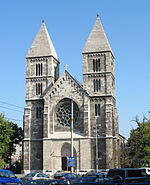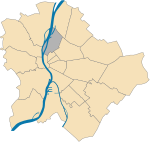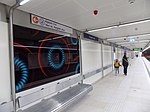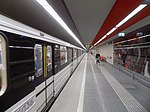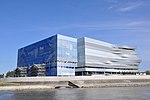Göncz Árpád városközpont metro station

Göncz Árpád városközpont (Árpád Göncz City Centre) is a station on the Budapest Metro Line 3 (North-South). It was the temporary terminus of Line 3 between 1984 and 1990.The station was opened on 7 November 1984 as part of the extension from Lehel tér. On 14 December 1990 the line was extended further north to Újpest-központ.The station is located beneath the intersection of Váci Avenue and Róbert Károly Boulevard, near Árpád bridge. It is also a major public transport hub.The area has several high-rise offices and governmental buildings, including the headquarters of the Hungarian Police, the National Health Insurance Fund (Országos Egészségbiztosítási Pénztár), Hungarian State Treasury (Magyar Államkincstár) and the National Pension Insurance Directorate (Országos Nyugdíjbiztosítási Főigazgatóság).From its inauguration until 31 January 2020, the station was called Árpád híd (Árpád Bridge). It then was renamed in honour of the former president of Hungary.
Excerpt from the Wikipedia article Göncz Árpád városközpont metro station (License: CC BY-SA 3.0, Authors, Images).Göncz Árpád városközpont metro station
Budapest Göncz Árpád városközpont
Geographical coordinates (GPS) Address Nearby Places Show on map
Geographical coordinates (GPS)
| Latitude | Longitude |
|---|---|
| N 47.532777777778 ° | E 19.067222222222 ° |
Address
1139 Budapest, Göncz Árpád városközpont
Hungary
Open on Google Maps
